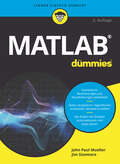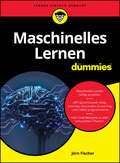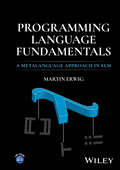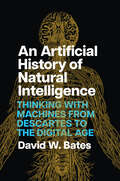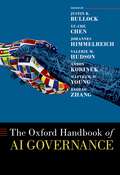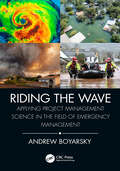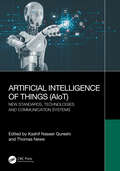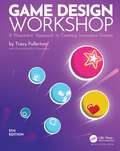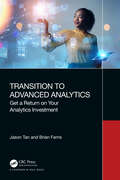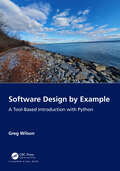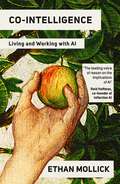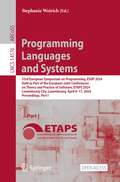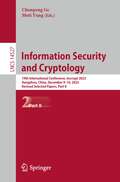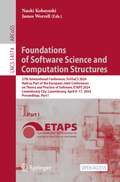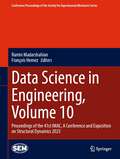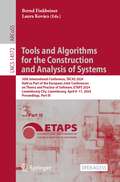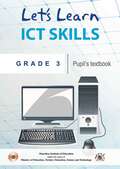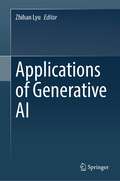- Table View
- List View
Matlab für Dummies (Für Dummies)
by Jim Sizemore John Paul MuellerMATLAB® So lernen Sie MATLAB ideal zu nutzen Ob Naturwissenschaftler, Mathematiker, Ingenieur oder Datenwissenschaftler - mit MATLAB haben Sie ein mächtiges Tool in der Hand, das Ihnen die Arbeit mit Ihren Daten erleichtert. Aber wie das mit manch mächtigen Dingen so ist - es ist auch ganz schön kompliziert. Aber keine Sorge! Die Autoren führen Sie in diesem Buch Schritt für Schritt an das Programm heran - von der Installation und den ersten Skripten bis hin zu aufwändigen Berechnungen, der Erstellung von Grafiken und effizienter Fehlerbehebung. Sie werden begeistert sein, was Sie mit MATLAB alles anstellen können. Sie erfahren Was es mit dem MATLAB-Dateisystem auf sich hat Wie Sie mathematische Operationen mit Vektoren und Matrizen durchführen Wie Sie Funktionen und Skripte erstellen Wie Sie importieren, exportieren und publizieren.
Maschinelles Lernen für Dummies (Für Dummies)
by Jörn FischerAlgorithmen für künstliches Lernen verstehen Maschinelles Lernen ist eines der wichtigsten Teilgebiete der künstlichen Intelligenz und das Verstehen und Entwickeln von passenden Algorithmen bleibt die große Herausforderung. Dieses Buch bietet einen außergewöhnlich umfassenden Überblick über die neuesten Algorithmen und die bereits bewährten Verfahren. Jörn Fischer beschreibt nicht nur deren Funktionsweise, sondern gibt für alle Bereiche verständliche Beispiele, die detailliert beschrieben und leicht nachvollziehbar sind. Außerdem werden hilfreiche Methoden zur Fehlersuche und -beseitigung an die Hand gegeben. Sie erfahren Wie Sie mit Python und Frameworks starten Wie Sie Optimierung, Clustering und Klassifizierung umsetzen Wie generative Methoden und Reinforcement Learning funktionieren Wie neuronale Netze arbeiten und erklärbar werden
Programming Language Fundamentals: A Metalanguage Approach in Elm
by Martin ErwigPROGRAMMING LANGUAGE FUNDAMENTALS Understand the key principles of programming languages Programming languages are the tools needed to let algorithms run on electronic computers. As they form the linguistic interface between humans and machines, the understanding of programming languages is essential for being able to control machine behavior. Programming Language Fundamentals offers a precise, comprehensive introduction to the principles that are the basis of most programming languages. Explaining both functional programming and logic programming, it presents a broad perspective on programming and constitutes an indispensable introduction to the foundations of programming languages. Programming Language Fundamentals readers will also find: Introduction to Elm as a metalanguage to encourage thinking and experimenting with programming languages in a formal way Detailed discussion of topics including abstract syntax, semantics, types, and more In-depth explanations of key concepts such as scope and parameter passing Programming Language Fundamentals is ideal for undergraduate students in computer science, as well as researchers and practitioners working with programming languages who are looking to broaden their understanding of the field.
An Artificial History of Natural Intelligence: Thinking with Machines from Descartes to the Digital Age
by David W. BatesA new history of human intelligence that argues that humans know themselves by knowing their machines. We imagine that we are both in control of and controlled by our bodies—autonomous and yet automatic. This entanglement, according to David W. Bates, emerged in the seventeenth century when humans first built and compared themselves with machines. Reading varied thinkers from Descartes to Kant to Turing, Bates reveals how time and time again technological developments offered new ways to imagine how the body’s automaticity worked alongside the mind’s autonomy. Tracing these evolving lines of thought, An Artificial History of Natural Intelligence offers a new theorization of the human as a being that is dependent on technology and produces itself as an artificial automaton without a natural, outside origin.
An Artificial History of Natural Intelligence: Thinking with Machines from Descartes to the Digital Age
by David W. BatesA new history of human intelligence that argues that humans know themselves by knowing their machines. We imagine that we are both in control of and controlled by our bodies—autonomous and yet automatic. This entanglement, according to David W. Bates, emerged in the seventeenth century when humans first built and compared themselves with machines. Reading varied thinkers from Descartes to Kant to Turing, Bates reveals how time and time again technological developments offered new ways to imagine how the body’s automaticity worked alongside the mind’s autonomy. Tracing these evolving lines of thought, An Artificial History of Natural Intelligence offers a new theorization of the human as a being that is dependent on technology and produces itself as an artificial automaton without a natural, outside origin.
The Oxford Handbook of AI Governance (Oxford Handbooks)
As the capabilities of Artificial Intelligence (AI) have increased over recent years, so have the challenges of how to govern its usage. Consequently, prominent stakeholders across academia, government, industry, and civil society have called for states to devise and deploy principles, innovative policies, and best practices to regulate and oversee these increasingly powerful AI tools. Developing a robust AI governance system requires extensive collective efforts throughout the world. It also raises old questions of politics, democracy, and administration, but with the new challenges posed by AI's growing influence on markets, governing structures, international relations, healthcare, science, and political activism. The Oxford Handbook of AI Governance delineates the scope of these issues and addresses the key questions of AI governance. Across forty-nine chapters, organized in nine major sections, the Handbook covers the theoretical and ethical foundations of AI governance, different frameworks for developing a governance structure for AI, practical perspectives on AI governance in different policy domains, economic analyses of AI governance, and concrete lessons about the impact of AI governance domestically and internationally. Chapter authors come from a wide set of disciplines, areas of study, and cultural backgrounds, providing a global perspective on AI governance.
The Oxford Handbook of AI Governance (Oxford Handbooks)
by Justin B. Bullock, Yu-Che Chen, Johannes Himmelreich, Valerie M. Hudson, Anton Korinek, Matthew M. Young and Baobao ZhangAs the capabilities of Artificial Intelligence (AI) have increased over recent years, so have the challenges of how to govern its usage. Consequently, prominent stakeholders across academia, government, industry, and civil society have called for states to devise and deploy principles, innovative policies, and best practices to regulate and oversee these increasingly powerful AI tools. Developing a robust AI governance system requires extensive collective efforts throughout the world. It also raises old questions of politics, democracy, and administration, but with the new challenges posed by AI's growing influence on markets, governing structures, international relations, healthcare, science, and political activism. The Oxford Handbook of AI Governance delineates the scope of these issues and addresses the key questions of AI governance. Across forty-nine chapters, organized in nine major sections, the Handbook covers the theoretical and ethical foundations of AI governance, different frameworks for developing a governance structure for AI, practical perspectives on AI governance in different policy domains, economic analyses of AI governance, and concrete lessons about the impact of AI governance domestically and internationally. Chapter authors come from a wide set of disciplines, areas of study, and cultural backgrounds, providing a global perspective on AI governance.
Riding the Wave: Applying Project Management Science in the Field of Emergency Management (ISSN)
by Andrew BoyarskyEmergency managers and public safety professionals are more frequently being called on to address increasingly challenging and complex critical incidents, with a wider variety and intensity of hazards, threats, and community vulnerabilities. Much of the work that falls into the scope of emergency managers – prevention, preparedness, mitigation – is “blue sky planning” and can be contained and effectively managed within projects. This book provides a foundational project management methodology relevant to emergency management practice, and explains and demonstrates how project management can be applied in the context of emergency and public safety organizations.Special features include: an initial focus on risk assessment and identification of mitigation and response planning measures; a clear set of better practices, using a diverse set of examples relevant to today’s emergency environment, from projects to develop emergency response exercises to application development to hazard mitigation; a framework for managing projects at a strategic level and how to incorporate this into an organization’s program, and presents how to develop and manage an emergency program and project portfolio; and suitability as both a hands-on training guide for emergency management programs and a textbook for academic emergency management programs. This book is intended for emergency managers and public safety professionals who are responsible for developing emergency programs and plans, including training courses, job aids, computer applications and new technology, developing exercises, and for implementing these plans and components in response to an emergency event. This audience includes managers in emergency and first response functions such as fire protection, law enforcement and public safety, emergency medical services, public health and healthcare, sanitation, public works, business continuity managers, crisis managers, and all managers in emergency support functions as described by FEMA. This would include those who have responsibility for emergency management functions, even without the related title.
Riding the Wave: Applying Project Management Science in the Field of Emergency Management (ISSN)
by Andrew BoyarskyEmergency managers and public safety professionals are more frequently being called on to address increasingly challenging and complex critical incidents, with a wider variety and intensity of hazards, threats, and community vulnerabilities. Much of the work that falls into the scope of emergency managers – prevention, preparedness, mitigation – is “blue sky planning” and can be contained and effectively managed within projects. This book provides a foundational project management methodology relevant to emergency management practice, and explains and demonstrates how project management can be applied in the context of emergency and public safety organizations.Special features include: an initial focus on risk assessment and identification of mitigation and response planning measures; a clear set of better practices, using a diverse set of examples relevant to today’s emergency environment, from projects to develop emergency response exercises to application development to hazard mitigation; a framework for managing projects at a strategic level and how to incorporate this into an organization’s program, and presents how to develop and manage an emergency program and project portfolio; and suitability as both a hands-on training guide for emergency management programs and a textbook for academic emergency management programs. This book is intended for emergency managers and public safety professionals who are responsible for developing emergency programs and plans, including training courses, job aids, computer applications and new technology, developing exercises, and for implementing these plans and components in response to an emergency event. This audience includes managers in emergency and first response functions such as fire protection, law enforcement and public safety, emergency medical services, public health and healthcare, sanitation, public works, business continuity managers, crisis managers, and all managers in emergency support functions as described by FEMA. This would include those who have responsibility for emergency management functions, even without the related title.
Artificial Intelligence of Things (AIoT): New Standards, Technologies and Communication Systems
by Kashif Naseer Qureshi Thomas NeweThis book is devoted to the new standards, technologies, and communication systems for Artificial Intelligence of Things (AIoT) networks. Smart and intelligent communication networks have gained significant attention due to the combination of AI and IoT networks to improve human and machine interfaces and enhance data processing and services. AIoT networks involve the collection of data from several devices and sensor nodes in the environment. AI can enhance these networks to make them faster, greener, smarter, and safer. Computer vision, language processing, and speech recognition are some examples of AIoT networks.Due to a large number of devices in today’s world, efficient and intelligent data processing is essential for problem-solving and decision-making. AI multiplies the value of these networks and promotes intelligence and learning capabilities, especially in homes, offices, and cities. However, several challenges have been observed in deploying AIoT networks, such as scalability, complexity, accuracy, and robustness. In addition, these networks are integrated with cloud, 5G networks, and blockchain methods for service provision. Many different solutions have been proposed to address issues related to machine and deep learning methods, ontology-based approaches, genetic algorithms, and fuzzy-based systems.This book aims to contribute to the state of the art and present current standards, technologies, and approaches for AIoT networks. This book focuses on existing solutions in AIoT network technologies, applications, services, standards, architectures, and security provisions. This book also introduces some new architectures and models for AIoT networks.
Artificial Intelligence of Things (AIoT): New Standards, Technologies and Communication Systems
This book is devoted to the new standards, technologies, and communication systems for Artificial Intelligence of Things (AIoT) networks. Smart and intelligent communication networks have gained significant attention due to the combination of AI and IoT networks to improve human and machine interfaces and enhance data processing and services. AIoT networks involve the collection of data from several devices and sensor nodes in the environment. AI can enhance these networks to make them faster, greener, smarter, and safer. Computer vision, language processing, and speech recognition are some examples of AIoT networks.Due to a large number of devices in today’s world, efficient and intelligent data processing is essential for problem-solving and decision-making. AI multiplies the value of these networks and promotes intelligence and learning capabilities, especially in homes, offices, and cities. However, several challenges have been observed in deploying AIoT networks, such as scalability, complexity, accuracy, and robustness. In addition, these networks are integrated with cloud, 5G networks, and blockchain methods for service provision. Many different solutions have been proposed to address issues related to machine and deep learning methods, ontology-based approaches, genetic algorithms, and fuzzy-based systems.This book aims to contribute to the state of the art and present current standards, technologies, and approaches for AIoT networks. This book focuses on existing solutions in AIoT network technologies, applications, services, standards, architectures, and security provisions. This book also introduces some new architectures and models for AIoT networks.
Game Design Workshop: A Playcentric Approach to Creating Innovative Games
by Tracy Fullerton“Create the digital games you love to play.”Discover an exercise-driven, non-technical approach to game design without the need for programming or artistic experience with Game Design Workshop, Fifth Edition.Tracy Fullerton demystifies the creative process with clear and accessible guidance on the formal, dramatic, and dynamic systems of game design. Using examples of classic and popular games, illustrations of design techniques, and refined exercises to strengthen your understanding of how game systems function, this book gives you the skills and tools necessary to create a compelling and engaging game.This updated 5th edition brings deeper coverage of playcentric design techniques, including setting emotion-focused experience goals and managing the design process to meet them. It includes a host of new diverse perspectives from top industry game designers.Game Design Workshop puts you to work prototyping, playtesting, and revising your own games with time-tested methods and tools. These skills will provide the foundation for your career in any facet of the game industry including design, producing, programming, and visual design.
Game Design Workshop: A Playcentric Approach to Creating Innovative Games
by Tracy Fullerton“Create the digital games you love to play.”Discover an exercise-driven, non-technical approach to game design without the need for programming or artistic experience with Game Design Workshop, Fifth Edition.Tracy Fullerton demystifies the creative process with clear and accessible guidance on the formal, dramatic, and dynamic systems of game design. Using examples of classic and popular games, illustrations of design techniques, and refined exercises to strengthen your understanding of how game systems function, this book gives you the skills and tools necessary to create a compelling and engaging game.This updated 5th edition brings deeper coverage of playcentric design techniques, including setting emotion-focused experience goals and managing the design process to meet them. It includes a host of new diverse perspectives from top industry game designers.Game Design Workshop puts you to work prototyping, playtesting, and revising your own games with time-tested methods and tools. These skills will provide the foundation for your career in any facet of the game industry including design, producing, programming, and visual design.
Transition to Advanced Analytics: Get a Return on Your Analytics Investment
by Jason Tan Brian FerrisAmazon knows the products we’re interested in and shows us more to boost the size of our shopping cart. Google Maps knows the best route to get from A to B and recommends it to get us there in the shortest possible time. Netflix knows the media we enjoy most and recommends more to boost streaming time. However, many companies still fall short with their data analytics practices.This book focuses on how to embed advanced analytics directly into daily business operations and complement an enterprise system. This book can guide you in how traditional industries like retailers, banks and insurers can utilise and develop advanced analytics complementing their enterprise systems while embedding advanced analytics directly to optimise revenue and customer experience. Detailed in this book is a world-class analytics application used by loyalty point providers, banks, insurers and leading retailers.The title also provides a step-by-step implementation framework for Chief Digital and Artificial Intelligence Offices to develop their advanced analytics capabilities in tandem with legacy IT systems.
Transition to Advanced Analytics: Get a Return on Your Analytics Investment
by Jason Tan Brian FerrisAmazon knows the products we’re interested in and shows us more to boost the size of our shopping cart. Google Maps knows the best route to get from A to B and recommends it to get us there in the shortest possible time. Netflix knows the media we enjoy most and recommends more to boost streaming time. However, many companies still fall short with their data analytics practices.This book focuses on how to embed advanced analytics directly into daily business operations and complement an enterprise system. This book can guide you in how traditional industries like retailers, banks and insurers can utilise and develop advanced analytics complementing their enterprise systems while embedding advanced analytics directly to optimise revenue and customer experience. Detailed in this book is a world-class analytics application used by loyalty point providers, banks, insurers and leading retailers.The title also provides a step-by-step implementation framework for Chief Digital and Artificial Intelligence Offices to develop their advanced analytics capabilities in tandem with legacy IT systems.
Software Design by Example: A Tool-Based Introduction with Python
by Greg WilsonThe best way to learn design in any field is to study examples, and some of the best examples of software design come from the tools programmers use in their own work. Software Design by Example: A Tool-Based Introduction with Python therefore builds small versions of the things programmers use in order to demystify them and give some insights into how experienced programmers think. From a file backup system and a testing framework to a regular expression matcher, a browser layout engine, and a very small compiler, we explore common design patterns, show how making code easier to test also makes it easier to reuse, and help readers understand how debuggers, profilers, package managers, and version control systems work so that they can use them more effectively.This material can be used for self-paced study, in an undergraduate course on software design, or as the core of an intensive weeklong workshop for working programmers. Each chapter has a set of exercises ranging in size and difficulty from half a dozen lines to a full day’s work. Readers should be familiar with the basics of modern Python, but the more advanced features of the language are explained and illustrated as they are introduced.All the written material in this project can be freely reused under the terms of the Creative Commons - Attribution license, while all of the software is made available under the terms of the Hippocratic License. All proceeds from sale of this book will go to support the Red Door Family Shelter in Toronto.Features:• Teaches software design by showing programmers how to build the tools they useevery day• Each chapter includes exercises to help readers check and deepen their understanding• All the example code can be downloaded, re-used, and modified under an open license
Software Design by Example: A Tool-Based Introduction with Python
by Greg WilsonThe best way to learn design in any field is to study examples, and some of the best examples of software design come from the tools programmers use in their own work. Software Design by Example: A Tool-Based Introduction with Python therefore builds small versions of the things programmers use in order to demystify them and give some insights into how experienced programmers think. From a file backup system and a testing framework to a regular expression matcher, a browser layout engine, and a very small compiler, we explore common design patterns, show how making code easier to test also makes it easier to reuse, and help readers understand how debuggers, profilers, package managers, and version control systems work so that they can use them more effectively.This material can be used for self-paced study, in an undergraduate course on software design, or as the core of an intensive weeklong workshop for working programmers. Each chapter has a set of exercises ranging in size and difficulty from half a dozen lines to a full day’s work. Readers should be familiar with the basics of modern Python, but the more advanced features of the language are explained and illustrated as they are introduced.All the written material in this project can be freely reused under the terms of the Creative Commons - Attribution license, while all of the software is made available under the terms of the Hippocratic License. All proceeds from sale of this book will go to support the Red Door Family Shelter in Toronto.Features:• Teaches software design by showing programmers how to build the tools they useevery day• Each chapter includes exercises to help readers check and deepen their understanding• All the example code can be downloaded, re-used, and modified under an open license
Co-Intelligence: Living and Working with AI
by Ethan Mollick'Co-Intelligence is the very best book I know about the ins, outs, and ethics of generative AI. Drop everything and read it cover to cover NOW' Angela DuckworthConsumer AI has arrived. And with it, inescapable upheaval as we grapple with what it means for our jobs, lives and the future of humanity. Cutting through the noise of AI evangelists and AI doom-mongers, Wharton professor Ethan Mollick has become one of the most prominent and provocative explainers of AI, focusing on the practical aspects of how these new tools for thought can transform our world. In Co-Intelligence, he urges us to engage with AI as co-worker, co-teacher and coach. Wide ranging, hugely thought-provoking and optimistic, Co-Intelligence reveals the promise and power of this new era.
Programming Languages and Systems: 33rd European Symposium on Programming, ESOP 2024, Held as Part of the European Joint Conferences on Theory and Practice of Software, ETAPS 2024, Luxembourg City, Luxembourg, April 6–11, 2024, Proceedings, Part I (Lecture Notes in Computer Science #14576)
by Stephanie WeirichThe two-volume open access book set LNCS 14576 + 14577 constitutes the proceedings of the 33rd European Symposium on Programming, ESOP 2024, which was held during April 6-11, 2024, in Luxemburg, as part of the European Joint Conferences on Theory and Practice of Software, ETAPS 2024.The 25 full papers and 1 fresh perspective paper presented in these proceedings were carefully reviewed and selected from 72 submissions. The papers were organized in topical sections as follows:Part I: Effects and modal types; bidirectional typing and session types; dependent types; Part II: Quantum programming and domain-specific languages; verification; program analysis; abstract interpretation.
Information Security and Cryptology: 19th International Conference, Inscrypt 2023, Hangzhou, China, December 9–10, 2023, Revised Selected Papers, Part II (Lecture Notes in Computer Science #14527)
by Chunpeng Ge Moti YungThe two-volume set LNCS 14526 and 14527 constitutes the refereed proceedings of the 19th International Conference on Information Security and Cryptology, Inscrypt 2023, held in Hangzhou, China, during December 9–10, 2023.The 38 full papers and 7 short papers presented in these proceedings were carefully reviewed and selected from 152 submissions. The papers have been organized in the following topical sections: Part I: Signature; blockchain; cryptography primitive; public key cryptography; security and privacy; Part II: System security; cryptography engineering; cryptanalysis; short papers, posters.
Foundations of Software Science and Computation Structures: 27th International Conference, FoSSaCS 2024, Held as Part of the European Joint Conferences on Theory and Practice of Software, ETAPS 2024, Luxembourg City, Luxembourg, April 6–11, 2024, Proceedings, Part I (Lecture Notes in Computer Science #14574)
by Naoki Kobayashi James WorrellThe two open access volumes LNCS 14574 and 14575 constitute the proceedings of the 27th International Conference on Foundations of Software Science and Computation Structures, FOSSACS 2024, which took place in Luxembourg in April 2024.The 24 full papers included in this book were carefully reviewed and selected from 79 submissions. They were organized in topical sections as follows: Part I: Infinite games; categorical semantics; automata and synthesis; Part II: Types and programming languages; logic and proofs; infinite-state systems.
Data Science in Engineering, Volume 10: Proceedings of the 41st IMAC, A Conference and Exposition on Structural Dynamics 2023 (Conference Proceedings of the Society for Experimental Mechanics Series)
by Ramin Madarshahian François HemezData Science in Engineering, Volume 10: Proceedings of the 41st IMAC, A Conference and Exposition on Structural Dynamics, 2023, the tenth volume of ten from the Conference brings together contributions to this important area of research and engineering. The collection presents early findings and case studies on fundamental and applied aspects of Data Science in Engineering, including papers on:Novel Data-driven Analysis MethodsDeep Learning Gaussian Process AnalysisReal-time Video-based AnalysisApplications to Nonlinear Dynamics and Damage DetectionHigh-rate Structural Monitoring and Prognostics
Tools and Algorithms for the Construction and Analysis of Systems: 30th International Conference, TACAS 2024, Held as Part of the European Joint Conferences on Theory and Practice of Software, ETAPS 2024, Luxembourg City, Luxembourg, April 6–11, 2024, Proceedings, Part III (Lecture Notes in Computer Science #14572)
by Bernd Finkbeiner Laura KovácsThe open access book 3-volume set LNCS 14570-14573 constitutes the proceedings of the 30th International Conference on Tools and Algorithms for the Construction and Analysis of Systems, TACAS 2024, which was held as part of the European Joint Conferences on Theory and Practice of Software, ETAPS 2024, during April 6-11, 2024, in Luxembourg.The 53 full papers and 16 short SVComp contributions included in these proceedings were carefully reviewed and selected from 159 submissions. They were organized in topical sections as follows:Part I: STA and SMT solving; synthesis; logic and decidability; program analysis and proofs; proof checking; Part II: Model Checking; automata and learning; software verification; probabilistic systems; simulations; Part III: Neural networks; testing and verification; games; concurrency; SV-Comp 2024.
Let's Learn ICT Skills - Pupil's Book class 3 - MIE
by Mauritius Institute of EducationThe Computer Fundamentals module provides a comprehensive introduction to the world of computing, covering essential concepts and practical skills. It begins with an overview of computers and their types, such as desktops, laptops, and tablets, along with the fundamental components comprising them. Learners explore file management techniques, spreadsheet basics, and word processing tasks, including document formatting and clip art insertion. Presentation skills are developed through creating PowerPoint slideshows. Internet usage dos and don'ts, web addresses, webpage access, saving, and printing are explained, while multimedia tasks in MS Paint are covered. Furthermore, the module emphasizes health, safety, and ethical considerations related to computer usage, highlighting potential health issues like neck and back pain, and eye strain. By encompassing both theoretical knowledge and practical skills, the module equips learners with a solid foundation in computer literacy essential for modern-day endeavors.
Applications of Generative AI
by Zhihan LyuThis book provides a comprehensive introduction to Generative AI in terms of basic concepts, core technologies, technical architecture, and application scenarios. Readers gain a deeper understanding of the emerging discipline of Generative AI. This book covers the latest cutting-edge application technologies of Generative AI in various fields. It provides relevant practitioners with ideas to solve problems and deepen their understanding of Generative AI. At the same time, it guides and helps Generative AI and related industries to deepen their understanding of the industry and enhance professional knowledge and skills. Starting from reality, this book lists many cases and analyzes theories in a popular image. The book is useful for AI researchers and specifically for those working with the applications at hand (primarily medical imaging and construction/twinning industry). It covers a variety of cutting-edge technologies in Generative AI, which provides researchers with new research ideas.
